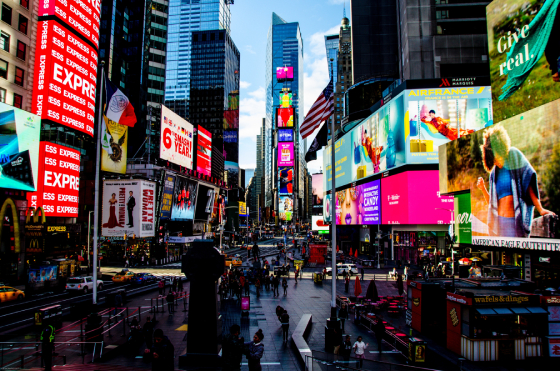Advertising has been in the spotlight for a few years because of its negative and positive impact on the ecological transition. A formidable weapon of communication, it can serve ecology as well as harm it. This is why, in recent years, in parallel with the collective awakening to environmental issues, advertising has begun to change. So, is it possible to think of advertising that reconciles ecological and social imperatives with economic issues?
Advertising and ecology an antagonism?
Advertising does not seem ecological if we pay attention to the way it is created
As a growing sector, advertising plays a very important economic role. A study of the weight of advertising in the European economy carried out by Deloitte revealed that for every 1 euro invested in advertising, 7 euros were generated in the European GDP. We understand the importance of advertising for the growth of companies.
However, they have a significant impact on energy consumption. It consumes a lot of energy on a global scale and aims for the most part to make the public consume these ads. However, as we know, currently the consumption mode of our societies is not really compatible with ecology.
A digital LCD advertising screen of 2m2 consumes 2 049 kWh/year, which is equivalent to the average electricity consumption of a French household, excluding heating. You also have to take into account the energy costs of manufacturing: for a 200kg panel, you have to count 8 tons of materials. This is without counting the digital advertising, which also consumes energy. According to Green IT, it would represent 39% of the weight of web pages, adding to the data saved by the already energy-intensive servers.

Advertising does not seem to be ecological either because of its primary purpose: to make people consume.
Their production and consumption are important, that’s a fact. However, as you know, communication, especially advertising, has a major influence on society. It allows to transmit messages, values, cultural and consumption models which then contribute to the evolution of the imaginary and the norms or representations that it conveys. A sort of self-fulfilling prophecy in short.
Advertising also has a role of incitement to purchase, which further encourages consumption and a consumer society.

So many parameters that seem to be contradictory with an ecological advertising concept. However, in addition to being a formidable weapon for promoting the capitalist system and a model of overconsumption, it is an effective tool for helping to orient people’s choices. Thus, could advertising not serve the ecological transition?
Green advertising: A green turn in the advertising industry
Faced with the evolution of mentalities and the ecological awareness of many actors, advertising is trying to adapt.
Green advertising: a tool for the ecological transition.
This evolution is first visible through the messages conveyed by advertisements, which are more and more focused on ecology.
More and more, advertisements put forward messages concerning ecology: these messages can be advertising campaigns of brands developing an ecological product or service, or they can be made compulsory. For example, the indication of the carbon impact of an advertisement or a service must be indicated in certain sectors such as transport.
This is a demand from consumers who are increasingly sensitive to environmental issues. Since 9 out of 10 people consider that companies encourage them to overconsume. Moreover, 78% would like to have information about the environmental and social impact of the goods they buy.
Given this data, we understand that the population’s expectations concerning respect for the environment are growing. This is also reflected in the numerous popular mobilizations concerning the environment.

Brands have understood this, which is why they affirm or reaffirm their ecological convictions. As a result, advertisements advocating ecological messages are produced, whether they are part of government campaigns, NGOs or brands.
If ecological messages on advertisements are multiplying, so are the accusations of greenwashing. The affirmation of an ecological transition of the brands that the advertisements relay remains to be relativized, and in fact, the ecological transition of the advertising messages also.
This is for example the case of Adidas during its campaign for the new 50% recycled stan smith.
An ecological conception of advertising: the economy of advertising in ecological transition?
Let’s look at the changes in the advertising industry. In addition to the messages disseminated by advertising, it is important to look at the organization of the advertising economy. Is it ecological or at least in ecological transition?

Whether it is NGO reports or proposals from political groups, many regulations, laws or ideas for regulations for the advertising industry are being developed. It seems that the advertising industry, including advertisers, consulting agencies and broadcasters, are not fully aware of sustainability requirements when designing or approving ads.
Some regulations are developing and concern the form of advertisements (display modes, production of supports…) aiming at making them more eco-responsible. The advertising sector, known for its self-regulation, is also taking some measures to be more attentive to these issues.
It is totally in its interest since many consumers are attentive to the ecological commitment of a brand, which also passes by the conditions of realization of the advertising campaigns. Indeed, more and more consumers are inclined to offer their trust to a brand that proposes sustainable products.
Examples of regulations and actions taken by the advertising industry
Many groups and reports are coming out on the industry’s commitment to sustainability. On a more international scale, Greenpeace and SPIM Big Corpo also publish reports and studies on the advertising sector and sustainable development.
Reducing the carbon footprint of campaigns is one of the main lines of action chosen by the advertising sector to make its ecological transition. This reduction is envisaged through new ways of conceiving advertising creations based on eco-design but also at the level of the actors of the advertising chain.
Many regulations concern the production of advertising. For example, it is forbidden to post mail in mailboxes indicating “STOP PUB” in order to act on the environment by reducing the quantity of paper produced. Also, paper advertisements are required to be printed on bio-degradable paper. These regulations aim to restrict the ecological impact of advertising.

In 2019, the Conseil Paritaire de la Publicité de l’ARPP (association representing the top 100 advertisers), founder of the European Advertising Ethics Alliance (AEEP), shared an opinion on sustainable development and this led to the commitment of these advertisers to respect many recommendations.
It is in the continuity of these measures that some agencies, although few in number, have modified their model. For example, in March 2020, the Publicis agency launched “no impact for big impact”, a program aimed at meeting the following objective: 2025 of 100% of campaigns proposed to clients eco-designed, 100% eco-produced and with a carbon footprint.
What are the advantages of green advertising for your company?
-
Green messages on advertisements are on the rise and are very popular with consumers.
As we have seen, there are many indicators that brands and advertisements could benefit from green advertising campaigns and the sale and production of more responsible products.
However, many advertising campaigns are accused of greenwashing, so before launching an advertising campaign with green messages, it is important to ensure consistency.
-
Choosing environmentally conscious advertisers as a sign of modernity
-
Reduce its environmental impact and respect its CSR charter strengthen its brand image and attract talent.
Many professionals in the advertising sector, and more generally in the business world, agree on the fact that many actors want more attention from companies on CSR. Thus, Sarah Barukh, a lecturer in ethical communication strategy at ISEG confides “It is obvious that many young people do not want to work in certain agencies that do not have a CSR approach”.
Examples of responsible advertising campaigns
Chocapic
For its “Funnily More Responsible Chocapic” campaign, which highlights the brand’s more responsible commitments, the brand opted for an eco-designed advertising campaign. The characters were modeled in wood and clay, the sets were made of recycled materials, and the electricity used for the shooting was 100% green.
The advert was certified by Albert, the leading authority on sustainable development in the film and television industry.
Aigle
Aigle reaffirms its ecological values with this commercial
Biocoop French organic store network
The brand wanted a communication that reflected its ecological commitments, so its agency had to rethink the production process so that the teams’ transportation, lighting and post-production were more responsible.
The advertising sector could be a player in the environmental cause. Numerous initiatives exist and are being launched, suggesting that there is significant room for maneuver for the ecological transition of the advertising sector. It is beginning to become aware of the ecological stakes but efforts seem to have to be reinforced in order to ensure a real transition.

